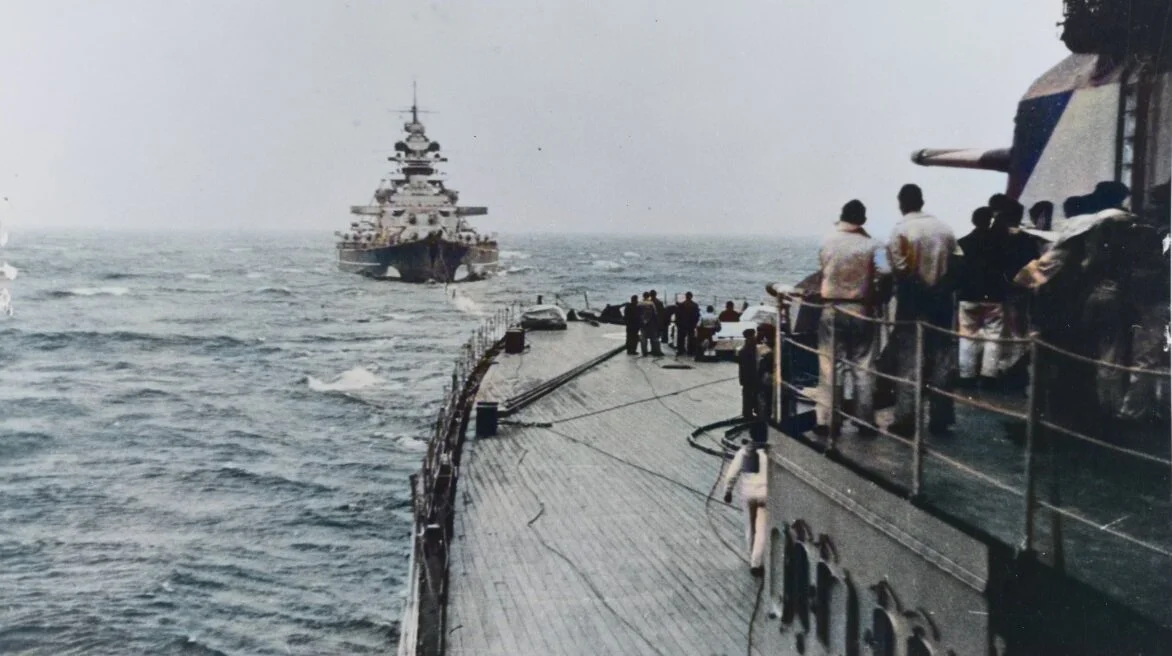Thursday, May 22
The Home Fleet Sorties
HMS Hood underway (Royal Navy)
As the clock struck midnight in Scapa Flow on May 22 Admiral Tovey issued orders for Admiral Holland to sortie out with the Battlecruiser Squadron, taking HMS Hood and HMS Prince of Wales to take up stations to block the passage between Iceland and the Faroes. In the dark of the night, the two massive warships, the pride of the King’s fleet and his newest battleship moved out of the anchorage, the boom ships closing the submarine barriers behind them as they steamed into the darkness.
Bismarck behind Prinz Eugen during exercises in the Baltic (US Navy)
For the Germans, the weather is favorable: the skies are overcast and rain squalls aid in concealing the two ships of the task force as they make their way northward. This helps the morale aboard them, aided even more at 0900, when Admiral Lutjens receives a report from his intelligence officer that the British are no longer aware of the position of the task force. Later in the day, Lutjens signals Prinz Eugen to confirm his earlier orders to break out into the Atlantic via the Denmark Straight, sending this at noon along with orders to paint over the large German flags on the decks of his ships. Intended to be an aerial recognition symbol, they are now out of range of the Luftwaffe’s air cover, rendering them redundant.
The concealment of the two ships is increased even more in the afternoon, as by 1800 the rain has increased to the point that they have difficulty keeping contact even with each other. The British are by this point only able to isolate the Germans to the entire Norwegian Sea.
A Martin Maryland on a foggy British airfield (Royal Air Force)
The poor weather had grounded RAF Coastal Command’s aircraft operating over the Norwegian sea, and a desire to have an update on the German task force led a Fleet Air Arm Martin Maryland bomber to take off from the Naval Air Station at Hatson in Scotland, braving the poor weather to get updated reports of German ships in Bergen. Most of the FAA aircraft available were Fairey Albacore torpedo bombers of No.828 Squadron, and Tovey had rebased them to the Shetland Islands in the event that the Germans came within range during a pass between Iceland and the Faroes. Taking off at 1640, they made the dangerous instrument flight to Norway, and at 1939 the pilot, Lieutenant Noel Goddard, radioed back that the Fjords were devoid of the task force. This was to be the last report needed by Admiral Tovey, who ordered the Home Fleet to sortie out at 2200.
At 2245 the fleet began to leave the harbor, led by Tovey’s flagship HMS King George V and the carrier HMS Victorious and a screen of escort destroyers. The fleet steams out of the harbor and turns course to the northwest, increasing speed as they moved to block the impending German breakout.
Despite these movements, the Germans still believed they were undetected, with reconnaissance reports arriving aboard Bismarck that the Home Fleet remained comfortably at anchor in Scapa Flow. Reports from U-boats were also forwarded, detailing promising convoys for the task force to engage upon breaking into the open ocean.
Hitler at the Berghof with Albert Speer during a conference (German Federal Archives)
As the 22nd of May wore on, far to the south Grand Admiral Raeder was in the Alps, reporting to the Fuhrer on the conduct of the Battle of the Atlantic. Following a long series of reports on U-boat operations, he slips in a brief mention of the commencement of Exercise Rhine, omitting any information regarding the lack of communication with Lutjens on the planned route of the breakout or the possible sighting by the Gotland on May 21. The dictator was not thrilled to hear of this action, in particular that he was only informed several days after it actually commenced.
The ensuing argument turned to the danger of drawing the United States into the conflict, with Hitler quite adamant that the Americans be kept out until after the destruction of the Soviet Union. He even requested Raeder recall the task force, but the Grand Admiral was not to be moved. He insisted the operation had passed the point of no return, and as a result Hitler reluctantly consented. Exercise Rhine would continue.
The German task force changes course to head for the Denmark Straight at the latitude of Narvik.
Admiral Wake Walker’s cruisers screen the entrance to the Denmark Straight.
The Battlecruiser Squadron steams northward to guard the passage between Iceland and the Faroes.
Admiral Tovey and the Home Fleet sortie from Scapa Flow in the late evening.




